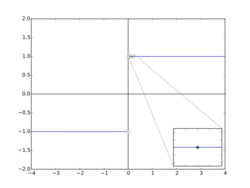Locally constant function
In mathematics, a function f from a topological space A to a set B is called locally constant if for every a in A there exists a neighborhood U of a such that f is constant on U.
Every constant function is locally constant.
Every locally constant function from the real numbers R to R is constant, by the connectedness of R. But the function f from the rationals Q to R, defined by f(x) = 0 for x < π, and f(x) = 1 for x > π, is locally constant (here we use the fact that π is irrational and that therefore the two sets {x∈Q : x < π} and {x∈Q : x > π} are both open in Q).
If f : A → B is locally constant, then it is constant on any connected component of A. The converse is true for locally connected spaces (where the connected components are open).
Further examples include the following:
- Given a covering map p : C → X, then to each point x of X we can assign the cardinality of the fiber p−1(x) over x; this assignment is locally constant.
- A map from a topological space A to a discrete space B is continuous if and only if it is locally constant.
Connection with sheaf theory
There are sheaves of locally constant functions on X. To be more definite, the locally constant integer-valued functions on X form a sheaf in the sense that for each open set U of X we can form the functions of this kind; and then verify that the sheaf axioms hold for this construction, giving us a sheaf of abelian groups (even commutative rings). This sheaf could be written ZX; described by means of stalks we have stalk Zx, a copy of Z at x, for each x in X. This can be referred to a constant sheaf, meaning exactly sheaf of locally constant functions taking their values in the (same) group. The typical sheaf of course isn't constant in this way; but the construction is useful in linking up sheaf cohomology with homology theory, and in logical applications of sheaves. The idea of local coefficient system is that we can have a theory of sheaves that locally look like such 'harmless' sheaves (near any x), but from a global point of view exhibit some 'twisting'.
This article does not cite any external source. HandWiki requires at least one external source. See citing external sources. (2021) (Learn how and when to remove this template message) |
 |


